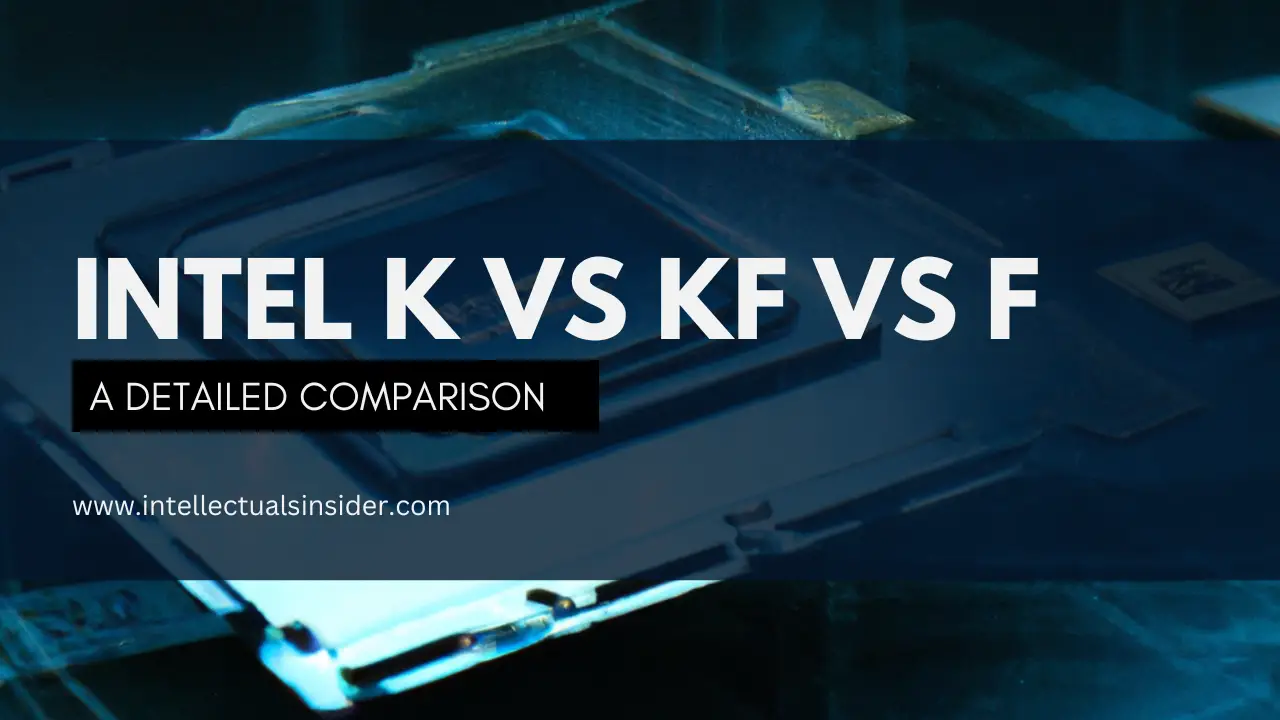Technology
Intel K vs KF vs F: Which Processor is Right for You?

The terms “K,” “KF,” and “F” might have appeared while you were browsing for an Intel CPU and you might have been confused as to what they meant. These letters stand for numerous CPU varieties with various features and performance levels. The primary differences between Intel K, KF, and F processors will be covered in this post so you may pick the one that works best for you.
Intel K processors were designed for gamers and enthusiasts who need the best performance. They have multipliers that may be unlocked, making it easier to overclock and boost the performance of the processor. There are two popular K processor models: Core i5-7600K and Core i9-10900K. High-end workstations and gaming PCs typically use these processors.
The Core i5-7600K and the Core i9-10900K are two well-known instances of K CPUs. High-end workstations and gaming PCs frequently use these processors.
KF CPUs from Intel are comparable to K processors, however, they lack an integrated graphics processor (IGP). To display images on your monitor, you will therefore need to use a separate graphics card.
If you want to overclock your processor without worrying about overheating or if you’re designing a tiny form factor PC, KF processors are a suitable option.
Processors with the KF moniker include the Core i5-10600KF and Core i9-11900KF. These processors are often found in workstations and gaming PCs with specialized graphics cards.
Intel K processors
High-performance processors with gaming and enthusiasts in mind are Intel K processors. The fact that K CPUs have unlocked multipliers makes it simpler to overclock the processor and is one of their distinguishing characteristics.
Through overclocking, you can increase your processor’s performance by using a frequency that is higher than the factory setting. If you want your computer to run faster, this can be helpful, but it can also increase the risk of overheating and voiding the processor’s warranty.
The Core i5-7600K and Core i9-10900K are two CPUs from Intel that are examples of the K series. These CPUs are frequently found in high-end workstations and gaming PCs, where their added performance might be beneficial.
Intel KF processors
Intel KF CPUs are high-performance processors made for enthusiasts and gamers, just like K processors. To display graphics on your monitor, you must utilize a separate graphics card because KF CPUs lack an integrated graphics processor (IGP).
One of the primary distinctions between K and KF processors is that KF processors are incompatible with PCs without a dedicated graphics card due to the absence of an IGP.
The processor can use less power and produce less heat as a result of the absence of an IGP in specific circumstances, though. Building a tiny form factor PC or wanting to overclock your processor without worrying about overheating might both benefit from this.
The Core i5-10600KF and the Core i9-11900KF are two instances of Intel KF CPUs. These processors are frequently found in high-end workstations and gaming PCs that include a dedicated graphics card.
Intel F processors
In that they lack an integrated graphics processor, Intel F CPUs are comparable to KF processors. F processors, on the other hand, are made for consumers who are more cost-conscious and seeking a decent mix between performance and value. Although F processors normally cost less than K and KF processors, they function at a lesser level.
The absence of an IGP is one of the primary distinctions between F and non-F CPUs. This implies that using a separate graphics card to display images on your monitor will increase the cost of your computer as a whole.
The processor can use less power and produce less heat as a result of the absence of an IGP in specific circumstances, though.
The Core i3-10100F and the Pentium Gold G6400F are two instances of Intel F CPUs. These CPUs are frequently found in entry-level gaming PCs and low-cost workstations because of their reasonable prices and solid performance.
Decoding the Differences: A Comprehensive Guide to Intel K, KF, and F Processors
If you’re looking for an Intel processor, you may have seen the letters “K,” “KF,” and “F” and wondered what they stood for. These letters stand for several processor subtypes that provide various functionality and performance levels. We’ll go over the main distinctions among Intel K, KF, and F processors in this part so you can choose the one that’s best for you.
For enthusiasts and gamers who want the highest performance, Intel K processors were created. They have multipliers that can be unlocked, which makes it simpler to overclock and increase the processor’s performance.
The Core i5-7600K and the Core i9-10900K are two common K processor models. These processors are frequently found in high-end workstations and gaming PCs.
Similar to Intel K processors, Intel KF processors lack an integrated graphics processor (IGP). This indicates that if you want to see visuals on your monitor, you’ll need to use a different graphics card.
If you’re designing a tiny form factor PC or want to overclock your processor without worrying about overheating, KF processors are a fantastic option. The Core i5-10600KF and the Core i9-11900KF are two examples of KF CPUs. These processors are often found in workstations with dedicated graphics cards and gaming PCs.
Intel F CPUs are made for people on a tight budget that seek high performance at a lesser price. They lack an IGP, thus if you want to see visuals on your monitor, you’ll need to utilize a different graphics card.
Although F processors are more affordable than K and KF processors, they perform less well overall. The Core i3-10100F and Pentium Gold G6400F are two examples of F CPUs. These processors are frequently found in low-cost workstations and entry-level gaming PCs.
K, KF, or F: Understanding the Pros and Cons of Intel’s Processor Options
Let’s examine the benefits and drawbacks of each Intel K, KF, and F CPU type in more detail now that we have figured out how they differ from one another.
The most powerful processors are Intel K models, but they are also the priciest. They are simpler to overclock because their multipliers are unlocked, but if you want to do so, you run the risk of them overheating. For enthusiasts and gamers who are willing to pay for the finest performance, K CPUs are the ideal choice.
The lack of an integrated graphics processor (IGP) and the strong performance of Intel KF CPUs might occasionally be advantageous. They may not be appropriate for use in PCs without a dedicated graphics card because they do not perform as well as K processors. KF processors are a suitable option for workstations and gaming PCs that have a dedicated graphics card or for tiny form factor PCs without an IGP.
Although Intel F CPUs are reasonably priced, they perform less well than K and KF processors. Since they lack an IGP, an external graphics card must be used to display images on your monitor. F processors work well in entry-level gaming PCs and for consumers on a tight budget.
Unlock Your PC’s Potential: A Comparison of Intel K, KF, and F Processors
The type of CPU you select can have a significant impact on how well your PC performs. For enthusiasts and gamers who need the finest potential performance from their PC, Intel K CPUs are the ideal option since they offer the highest performance levels.
They feature multipliers that can be unlocked, which makes it simpler to overclock and increase the processor’s performance. However, K processors are also the most costly and, if you want to overclock them, they could be more prone to overheating.
The lack of an integrated graphics processor (IGP) and the strong performance of Intel KF CPUs might occasionally be advantageous.
They are a fantastic option for tiny form factor PCs without an IGP as well as workstations and gaming PCs with a dedicated graphics card. Although KF processors are a little less costly than K processors, they do not perform as well.
Although Intel F CPUs are reasonably priced, they perform less well than K and KF processors. Since they lack an IGP, an external graphics card must be used to display images on your monitor. F processors work well in entry-level gaming PCs and for consumers on a tight budget.
Intel Processor Showdown: K vs KF vs F – What’s the Best Choice for Your Needs?
F processor can be the best option for you if you have a limited budget and demand exceptional value. Although F processors have lower performance levels than K and KF processors, they nonetheless deliver decent performance for the money. Since they lack an IGP, an external graphics card must be used to display images on your monitor. F processors work well in entry-level gaming PCs and for consumers on a tight budget.
You might be wondering which Intel K, KF, or F CPU is the best option for your needs now that we’ve covered the main distinctions between them. The key factors to think about while choosing between K, KF, and F processors are outlined below:
- For enthusiasts and gamers who need the finest potential performance from their PC, Intel K CPUs are the ideal option since they offer the highest performance levels. Although they are the priciest, they feature multipliers that can be unlocked, making it simpler to overclock the processor and improve performance.
- The lack of an integrated graphics processor (IGP) and the strong performance of Intel KF CPUs might occasionally be advantageous. They are a fantastic option for tiny form factor PCs without an IGP as well as workstations and gaming PCs with a dedicated graphics card. Although KF processors are a little less costly than K processors, they do not perform as well.
- Although Intel F CPUs are reasonably priced, they perform less well than K and KF processors. Since they lack an IGP, an external graphics card must be used to display images on your monitor. F processors work well in entry-level gaming PCs and for consumers on a tight budget.
| Processor Type | Unlocked Multipliers | Integrated Graphics Processor (IGP) | Performance Level | Price | Best Use Cases |
|---|---|---|---|---|---|
| Intel K | Yes | Yes | High | High | Gaming PCs, high-end workstations, enthusiasts looking for the highest performance |
| Intel KF | Yes | No | High | High | Gaming PCs with dedicated graphics cards, high-end workstations with dedicated graphics cards, small form factor PCs, enthusiasts looking to overclock without worrying about overheating |
| Intel F | No | No | Moderate | Low | Entry-level gaming PCs, budget workstations, budget-conscious consumers looking for good value |
Here is a brief explanation of each column in the table:
- Processor Type: The next column lists the various Intel processor types that are being contrasted: KF, F, and K.
Unlocked Multipliers: The presence or absence of unlocked multipliers, which facilitate simpler overclocking, is indicated by this column for each processor. In contrast to F CPUs, K and KF processors feature unlocked multipliers. - Integrated Graphics Processor (IGP): This column indicates whether or not the processor includes an integrated graphics processor, which enables the processor to display images on a monitor without the need for an additional graphics card. While KF processors lack an IGP, K and F processors do.
- Performance Level: This column displays the processor’s overall performance level, with “High” denoting the maximum level of performance and “Moderate” denoting a more average level. The highest performance level is achieved by K processors, followed by KF processors, and finally F processors.
- Price: “High” denotes the most costly processors, while “Low” denotes the least expensive. This column shows the overall price range for each type of CPU. The most expensive processors are typically K and KF, whereas the least expensive processors are typically F processors.
- Best Use Cases: The situations or uses that are best suited to each type of processor are listed in this column. The best processors for gaming PCs and workstations with dedicated graphics cards are K processors, KF processors, and F processors, respectively. The least expensive and entry-level gaming PCs should use F processors.
Conclusion
The ideal option for you will rely on your demands in terms of performance and price. Intel K, KF, and F CPUs all provide varying degrees of performance and functionality.
For enthusiasts and gamers who need the finest potential performance from their PC, K CPUs are the ideal option since they provide the highest performance levels. KF processors are a suitable option for workstations with a dedicated graphics card and gaming PCs since they provide high performance and lack an IGP.
F processors are reasonably priced yet perform less well than K and KF processors. They work well with entry-level gaming PCs and users on a budget.
FAQ’s
- What distinguishes Intel K, KF, and F processors from one another?
Intel KF processors lack an integrated GPU, F processors are locked and do not support overclocking, while K processors are unlocked and do.
- What similarities and differences exist between the K, KF, and F processors from Intel?
In general, K and KF processors are more potent and capable of higher performance than F processors, but they also use more energy and produce more heat.
- Which processor is ideal for high-performance work or gaming?
Gaming or high-performance jobs like video editing or 3D rendering may benefit from Intel K or KF processors.
- Can I overclock a K or KF processor from Intel?
Yes, Intel K and KF processors can be overclocked and unlocked.
- Are there any changes between the Intel K, KF, and F processors in terms of power usage or heat output?
Compared to F processors, K and KF processors typically consume more power and produce more heat.
- I have an Intel F processor; can I upgrade to a K or KF processor?
It is feasible to upgrade from an Intel F processor to a K or KF processor, but in order to assure compatibility, you might also need to change your motherboard and other components.
- When deciding between Intel K, KF, and F processors, are there any compatibility difficulties or other things to take into account?
When deciding between Intel K, KF, and F CPUs, you should take into account your unique objectives and goals, your budget, your motherboard’s compatibility with other components, and the differences in features and capabilities.
- Are there any further sources (websites, discussion boards, etc.) that can assist me in choosing the best processor type for me?
You may compare and select the best processor for your needs using a variety of online resources, including forums and websites devoted to computer hardware. Before making a choice, it is usually a good idea to conduct your own study and evaluate the features and specs of several CPUs.
Technology
Sealing the Deal: How to Choose the Right Materials for Pipe Sealing

Pipes are an essential part of any plumbing system, and keeping them in good condition is crucial for the overall functionality of your home. One way to ensure that your pipes stay in top shape is by properly sealing them with the right materials.
In this guide, we will discuss the different types of materials used for pipe sealing and how to choose the best one for your specific needs.
Understanding Pipe Sealing
Before we dive into the details of materials for pipe sealing, it’s important to understand what pipe sealing actually means and why it is necessary.
Pipe sealing is the process of closing off any gaps or leaks in pipes to prevent water or gas from leaking out. This can be done for various types of pipes, including water supply pipes, drainage pipes, and gas pipes.
Proper pipe sealing not only prevents the wastage of resources but also protects your home from potential water damage and gas leaks.
Types of Pipe Sealing Materials
There are a variety of materials available for pipe sealing, each with its unique properties and uses. Some common types include:
Teflon Tape
Also known as plumber’s tape, Teflon tape is a thin, white tape made from PTFE (polytetrafluoroethylene) that is commonly used for sealing threaded pipe connections. It provides a tight, leak-proof seal and can withstand high temperatures and pressures.
Pipe Dope
Pipe dope is a paste-like substance made of oils, resins, and mineral fillers that is applied to the threaded part of pipes before they are connected. It creates a seal that is resistant to vibration and pressure fluctuations, making it a great choice for high-pressure systems. Unlike Teflon tape, which can be used only on threads, pipe dope can be applied to any connection needing a waterproof seal.
Pipe Plugs
Pipe plugs are physical barriers inserted into the ends of pipes to stop the flow of water or gas temporarily. They are often used during maintenance or repair work to isolate a section of the plumbing system without shutting off the entire system. Pipe plugs can be made from various materials, including metal, rubber, and plastic, each designed to withstand different pressures and temperatures. Knowing when and how to use pipe plugs effectively is crucial for anyone working on plumbing systems, as they provide a quick and easy solution for controlling the flow within pipes.
Choosing the Right Materials for Your Needs
Now that you understand the different types of materials used for pipe sealing, how do you choose the right one for your specific needs? Here are a few factors to consider:
Type of Pipes
The first thing to consider is the type of pipes in your plumbing system. Different materials may be better suited for certain types of pipes, so make sure to choose one that is compatible.
Type of Connection
The type of connection also plays a role in determining the right sealing material. For threaded connections, Teflon tape or pipe dope would be suitable, while pipe plugs are ideal for temporarily blocking off non-threaded connections.
Pressure and Temperature
The pressure and temperature within your plumbing system should also be taken into account. Make sure to choose materials that can withstand the levels of pressure and temperature within your pipes.
Reliability and Longevity
Lastly, consider the reliability and longevity of the sealing material you choose. You want a material that will provide a long-lasting seal to prevent any future leaks or problems.
Conclusion
Proper pipe sealing is essential for maintaining a functional plumbing system and protecting your home from potential damage. By understanding the different types of materials available and considering key factors, you can choose the right material to ensure a tight and lasting seal for your pipes. Remember, when it comes to pipe sealing, it’s always better to be safe than sorry. So take the time to choose the right materials and ensure the longevity and efficiency of your plumbing system.
-

 News3 weeks ago
News3 weeks agoHunting for the Ideal Coronagraph to Discover Earth 2.0
-

 News3 weeks ago
News3 weeks agoIs Biden Willing to Utilize America’s Leverage With Israel Despite Being ‘Outraged’?
-

 Entertainment2 weeks ago
Entertainment2 weeks agoActor Cole Brings Plenty, known for ‘1923’, tragically passes away at 27 following accusations of domestic violence.
-

 News2 weeks ago
News2 weeks agoWebb Observes a Galaxy Brimming with New Stars
-

 News2 weeks ago
News2 weeks agoMuseums are at Odds with Her Art, but Can’t Get Enough
-

 Entertainment3 weeks ago
Entertainment3 weeks agoJennie Garth Opens Up about Dan Schneider, Amanda Bynes, and the Atmosphere on Set
-

 News1 day ago
News1 day agoPossible Future Colleague of Trump: David Lammy, a Close Associate of Obama
-

 News23 hours ago
News23 hours agoKevin McCarthy, former House Speaker, seeks revenge





















